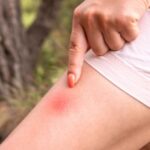
Bed bugs are one of the most frustrating pests Long Island homeowners deal with. They’re small and sometimes hard to spy, but they leave behind several noticeable traces that can indicate you have a problem. Whether you’ve been traveling to new places, riding public transportation, sending your kids back to school, or just want to be as informed as possible, here’s how you can better spot a bed bug infestation in your home.
What Are Bed Bugs? 
Bed bugs are small rusty-red pests that are nocturnal. Bed bugs feed on human blood by biting, most often while their hosts are fast asleep. In order to survive and develop, bed bugs need these blood meals. When they haven’t recently fed on a host, bed bugs’ bodies will appear clear and flat, but after they’ve taken a blood meal, their coloring changes to a purple-ish red color and they become larger in size.
Where Do Bed Bugs Hide?
Bed bugs are hitchhiking pests who will enter your home by any means possible. Because their bodies are small and flat, it’s easy for them to fit into tiny spaces and go unnoticed. Initially, when they make their way into your home, they will be found in mattresses, box springs, bed frames, and headboards for easy access to hosts to feed on during the night. Then, once those hosts begin moving their way around the home to areas such as the couch, the bed bugs will quickly expand into a full-blown bed bug infestation if not caught quickly. Over time, bed bugs may move away from their initial plush furniture where humans hang out, like the bed and sofa, and spread to dresses, crevices, and even nearby rooms, dorms, or apartments.
How to Check for Bed Bugs in the Couch
First off, if you have bed bugs in your couch, it’s very likely they’re in your mattress, too! While they gravitate toward your sleeping area, as mentioned earlier, from there they’ll spread around your house.
- Check underneath your couch cushions for visible signs of bed bugs
- Flip the couch over and check the underside of the furniture
- Inspect the frame of the couch, including any joints where they may be hiding
- Be on the lookout for dead bugs, which may be upside down, and like live bed bugs, around the size and color of an apple seed
- Do you see any signs of feces? It will appear as thick, dark droplets and smear initially, but later, will harden in place
- Look for bed bug shells
How to Check for Bed Bugs in the Mattress
As mentioned, mattresses are the most common place to see bed bugs in your home.
Here are the areas of your mattress to check:
- Cracks, crevices, tufts, and seams are excellent hiding places
- Folds within the fabric
- Do you see any blood spots on the mattress?
Using a flashlight and a stiff, flat-edged object like a credit card or paint scraper, check around beds, mattresses, and other areas where you suspect you might have bed bugs. Look for actual bugs, eggs, feces, or molted skin as evidence of an infestation. Be sure to look in the cracks, crevices, and folds of fabric and furniture. You may also want to wear protective gloves during this inspection. Bed bugs are attracted to warmth. The number one hiding place for bed bugs is in mattresses and beds. Inspect your sheets for blood spots bed bugs may have left behind. Be sure to thoroughly inspect the seams, tufts, and folds of your mattress in addition to any corners or crevices of your bed.
How to Check for Bed Bugs When You’re Traveling
- Don’t think a more expensive hotel will be clear of bed bugs; bed bugs are not an issue of sanitation.
- Thoroughly investigate the room before unpacking. Bring a small flashlight to help in dark areas. The headboard is the most likely place to find a bedbug.
- Store luggage in the bathroom or on top of counters or dressers.
- When repacking, put all clothes in plastic bags.
- Unpack bags at home outdoors, store luggage in the garage, and wash clothes immediately in hot water.
How to Get Rid of Bed Bugs Fast
Not sure where to start? Don’t want to get up close and personal with bed bugs? That’s why we’re here! Call (631/516) 864-6900 for a free bed bug treatment estimate.





